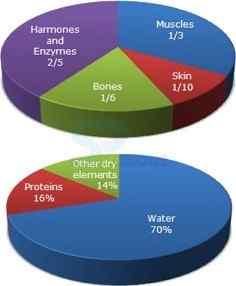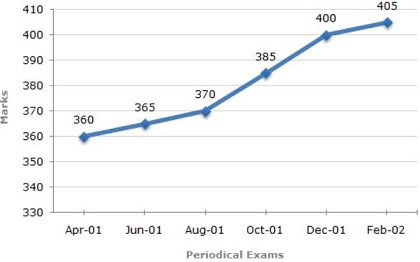 Introduction
Introduction
Data Interpretation is the ability to analyze, interpret and visualize the provided data to arrive at conclusions and to make inferences. Data Interpretation questions in the competitive exams is a test of analytical abilities. In the competitive exams, the Data Interpretation questions are grouped together and refer to the same table, graph or other data/visual presentation. The test takers are required to interpret or analyze the given data to answer the questions. In India, competitive exams related to employment in Banking, SSC, Insurance etc..have the Data Interpretation type of questions.
The article IBPS PO Data Analysis & Interpretation Quiz 5 provides Important Data Analysis & Interpretation Multiple choice questions useful to the candidates preparing IBPS PO Mains, Insurance and Bank Exams 2019.
 Quiz
Quiz
Directions (1-5): Study the following pie-diagrams carefully and answer the questions given below it:
Percentage Composition of Human Body
1. What percent of the total weight of human body is equivalent to the weight of the proteins in skin in human body?- A. 0.016
B. 1.6
C. 0.16
D. Data inadequate
- A. 20 kg
B. 35 kg
C. 41 kg
D. 42.5 kg
- A. 1 : 18
B. 1 : 2
C. 2 : 1
D. 18 : 1
- A. 54°
B. 126°
C. 108°
D. 252°
- A. [latex]\frac {1}{40}[/latex]
B. [latex]\frac {3}{80}[/latex]
C. [latex]\frac {2}{5}[/latex]
D. [latex]\frac {11}{15}[/latex]
Directions (1 to 5): The following pie chart shows the amount of subscriptions generated for India Bonds from different categories of investors.
Sales (in lakh number of packs) of five different products of Cosmetic Company during 1995 and 2000
1. The sales of lipsticks in 2000 was by what percent more than the sales of nail enamels in 2000? (rounded off to nearest integer)- A. 33%
B. 31%
C. 28%
D. 22%
- A. Shampoos
B. Nail enamels
C. Talcum powders
D. Lipsticks
- A. 7 : 2
B. 5 : 2
C. 4 : 3
D. 2 :1
- A. Lipsticks
B. Nail enamels
C. Talcum powders
D. Shampoos
- A. 57%
B. 36%
C. 29%
D. 25%
Directions (1 to 5): In a school the periodical examination are held every second month. In a session during April 2001 - March 2002, a student of Class IX appeared for each of the periodical exams. The aggregate marks obtained by him in each perodical exam are represented in the line-graph given below.
Marks Obtained by student in Six Periodical Held in Every Two Months During the Year in the Session 2001 - 2002. Maximum Total Marks in each Periodical Exam = 500
1. In which periodical exams did the student obtain the highest percentage increase in marks over the previous periodical exams ?- A. June, 01
B. August, 01
C. October, 01
D. December, 01
- A. 110%
B. 112.5%
C. 115%
D. 116.5%
- A. 73.25%
B. 75.5%
C. 77%
D. 78.75%
- A. 373
B. 379
C. 381
D. 385
- A. None
B. June, 01
C. Oct, 01
D. Feb, 02








